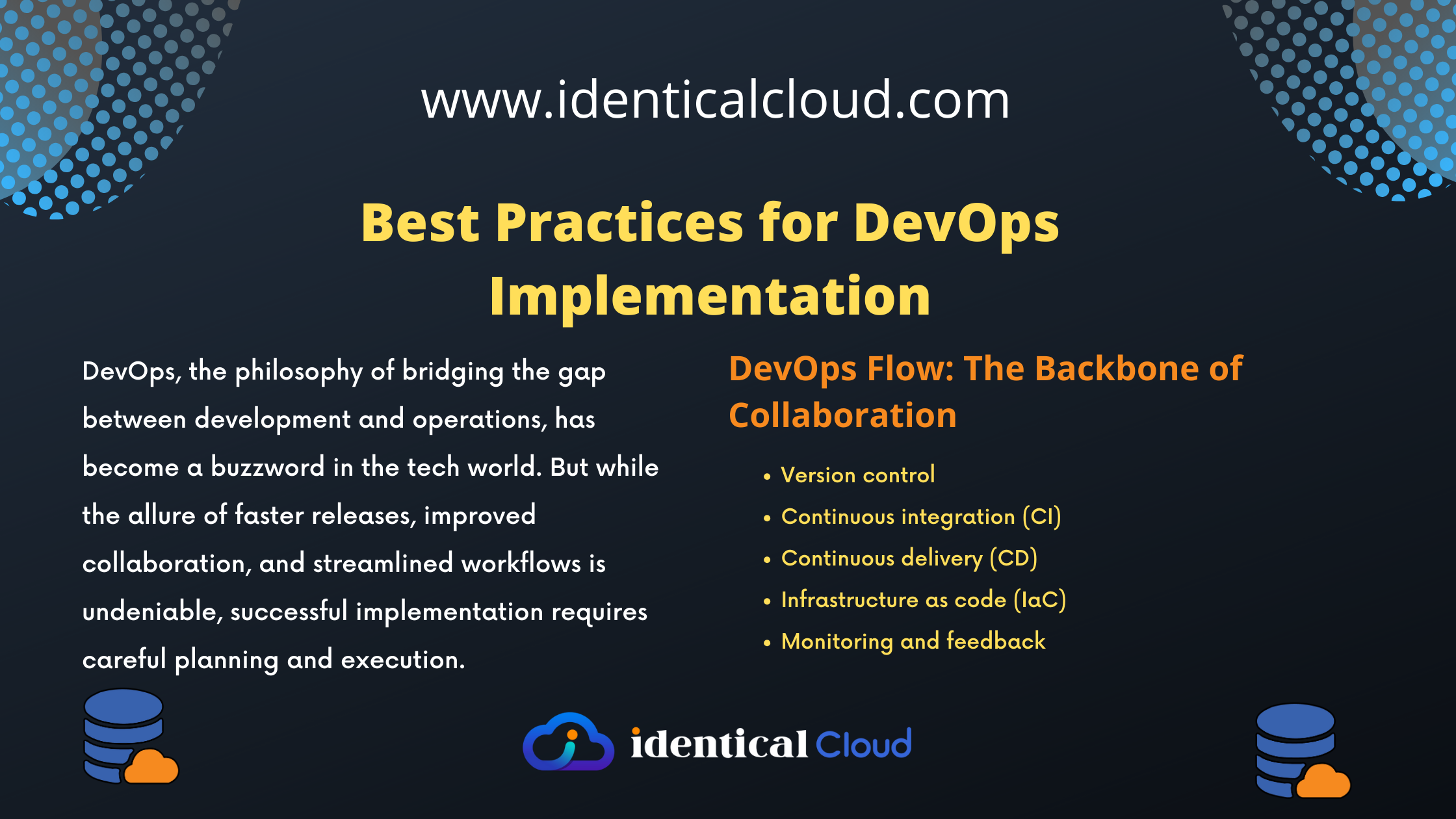
Best Practices for DevOps Implementation
Best Practices for DevOps Implementation
DevOps, the philosophy of bridging the gap between development and operations, has become a buzzword in the tech world. But while the allure of faster releases, improved collaboration, and streamlined workflows is undeniable, successful implementation requires careful planning and execution. This blog delves into the best practices that will guide you through the rapids of DevOps transformation, ensuring a smooth journey towards continuous delivery and increased value.
Best Practices for DevOps Implementation:
- Cultural Transformation:
- DevOps starts with a cultural shift, fostering collaboration and communication across development, operations, and other stakeholders.
- Encourage a culture of shared responsibility, where teams work together towards common goals.
- Automation:
- Automation is at the heart of DevOps. Automate repetitive tasks, including testing, deployment, infrastructure provisioning, and monitoring.
- Use tools like Jenkins, GitLab CI/CD, Ansible, Puppet, and Chef for automating various stages of the development pipeline.
- Continuous Integration (CI) and Continuous Deployment (CD):
- Implement CI/CD pipelines to automate the process of building, testing, and deploying software.
- Ensure that changes are integrated into the mainline frequently and that deployments are automated to reduce manual errors and accelerate time to market.
- Infrastructure as Code (IaC):
- Treat infrastructure as code by defining infrastructure configurations using code.
- Utilize tools like Terraform, AWS CloudFormation, or Azure Resource Manager templates to provision and manage infrastructure programmatically.
- Monitoring and Feedback:
- Implement robust monitoring and logging mechanisms to gain insights into application performance, system health, and user experience.
- Use tools such as Prometheus, Grafana, ELK Stack (Elasticsearch, Logstash, Kibana), and Splunk for monitoring and analysis.
- Security:
- Embed security practices into every stage of the development lifecycle.
- Utilize tools like SonarQube, OWASP ZAP, and Twistlock for static code analysis, vulnerability scanning, and container security.
DevOps Flow:
DevOps flow represents the sequence of activities involved in the software development and delivery process. It typically includes the following stages:
- Plan: Define project requirements, prioritize tasks, and plan sprints or iterations.
- Code: Develop and maintain code using version control systems like Git, SVN, or Mercurial.
- Build: Compile source code, run automated tests, and generate artifacts for deployment.
- Test: Execute unit tests, integration tests, regression tests, and performance tests to ensure code quality.
- Deploy: Automate deployment processes to push changes into production or staging environments.
- Operate: Monitor application and infrastructure health, troubleshoot issues, and ensure optimal performance.
- Feedback: Gather feedback from users and stakeholders to identify areas for improvement and iterate on the development process.
DevOps Patterns:
DevOps patterns represent proven solutions to common challenges encountered during the implementation of DevOps practices. Some popular DevOps patterns include:
- Immutable Infrastructure:
- Treat infrastructure as disposable and immutable, rebuilding it from scratch rather than making changes to existing instances.
- This pattern ensures consistency, repeatability, and easier rollback in case of failures.
- Blue-Green Deployment:
- Maintain two identical production environments (blue and green), with only one environment active at a time.
- Deploy changes to the inactive environment and switch traffic once the deployment is successful.
- Canary Deployment:
- Roll out new features or updates to a small subset of users before deploying them to the entire user base.
- Monitor the performance and gather feedback from the canary group before proceeding with full deployment.
- Feature Toggle:
- Implement feature toggles or feature flags to enable or disable specific features in production without deploying new code.
- This pattern allows for controlled feature releases and quick rollbacks in case of issues.
- Chaos Engineering:
- Intentionally inject failures and disruptions into production systems to test resilience and identify weaknesses.
- Use tools like Chaos Monkey, Gremlin, or Chaos Toolkit to simulate real-world failures and validate system reliability.
DevOps is a journey, not a destination. Embrace experimentation, learn from failures, and adapt your approach based on what works best for your organization. By adhering to best practices, employing relevant patterns, and navigating the implementation carefully, you can unlock the true potential of DevOps and ride the wave of continuous improvement towards digital excellence.
